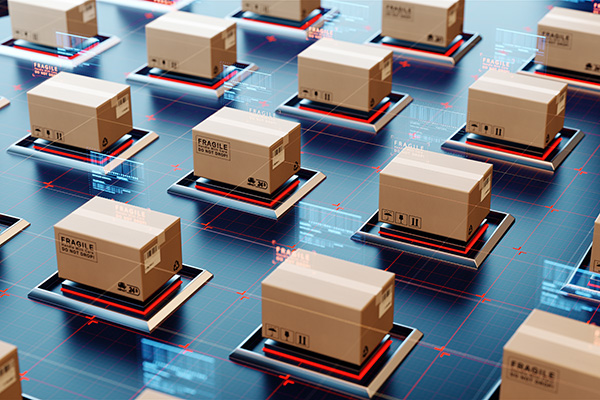Every so often it's good to look in on Amazon and see what it's doing to change supply chains, especially its own. As someone once said, Amazon is the de facto R&D lab for the entire supply chain.
And with good reason.
“When it comes to service in an on-demand world, there's a lot less time between the flash of when a customer wants something and the bang of when they have it,” says consultant David Schneider of David K. Schneider & Co.
“Customer service today is based on the perception of how well retailers manage the time between the flash and the bang,” he adds in a recent article in Modern Materials Handling.
In fact, “Amazon has done a fantastic job of making supply chain a competitive differentiator,” explains Jim Tompkins in NextGen: The Interview. At least part of that success comes from its leadership in supply chain digitization.
Which is important since digitization is as advanced as the supply chain gets these days. It recognizes variability in the moment (forget the forecast) and removes latency from a company's ability to react. Flash and bang.
Here's something that may have already happened to you. While placing an order at Amazon, you're offered next-day delivery if you spend a certain amount (which is, of course, more than you've already spent). But you pass on the offer and the package still arrives the next day. What happened?
“Quite simply, digital Amazon determined it was better for its processes to fill and ship your order for next day than wait an extra day. That's a digital supply chain right down to the individual based on what's best for Amazon,” Rich Sherman of Tata Consultancy Services explains in a recent NextGen Supply Chain interview. Perhaps just as important, it happened as you were placing your order. Advanced flash and bang.
Then there's the matter of delivery. We've all heard about Amazon buying some planes and probably seen Amazon 18-wheelers on the road. In 2016, the company called itself a “transportation service provider” for the first time.
A few weeks ago when the company filed its 10-K for 2018, it cited transportation and logistics services (such as FedEx, UPS and USPS) as competitors. That's a long way from being a simple provider.
In 2018, Amazon spent $27.7 billion on shipping. In 2015, it spent just $11.5 billion. That's a 140% increase in three years. But not just the total number has changed. According to Wolfe Research, 26% of Amazon's online orders are now handled by its own shipping network. Clearly, Amazon is looking at how it can improve what happens inside its four walls as well as outside the four walls.
When it comes to delivery trucks, we aren't just talking a fleet of conventional trucks. Amazon is already trying to jump to the autonomous type. In early February, there were reports of autonomous system supplier Embark testing self-driving semis with the Amazon logo. Neither company would comment on the CNBC report, but who's going to bet against Amazon on this one. It is also worth noting that these are not completely autonomous trucks and have a test driver on board. Just give it time.
That report came only days after Amazon announced its autonomous Scout vehicle for home delivery. No test driver on board. Testing of six vehicles is underway in Snohomish County, Washington, where they drive right up to your front door. “We are happy to welcome Amazon Scout to our growing suite of innovative delivery solutions,” says Sean Scott, VP of Amazon Scout. Worth watching going forward.
Here's another twist on that same theme. Amazon had a patent approved in late February that also eliminates human delivery of packages to your door. These so-called autonomous ground vehicles (AGVs) stay at your house and run out to the delivery truck when it arrives.
So is Amazon's Achilles heel here its carbon footprint? Don't worry. Amazon has that covered, at least partially. Later this year, the company says it will disclose the actual size of its carbon footprint.
But that's only one milestone. Amazon said in February that half of its deliveries will be “net zero” carbon or carbon neutral by 2030. Amazon recently invested in electric car maker Rivian. By the way, the e-commerce giant also plans to power all of its infrastructure with renewable energy. Not sure when, but stay tuned.
Are you surprised by any of this? To be honest, we all are to one degree or another. And as Tompkins points out in NextGen: The Interview, all this disruption is occurring as the cycle of innovation is accelerating across the supply chain. Which just reinforces the thought that it's never good to underestimate Amazon's dedication to so many dimensions of flash and bang. All at once.
Gary Forger is special projects editor for Supply Chain Management Review. He can be reached at [email protected].
SC
MR


More Events
- Looking back at NextGen 2024
- Mattel’s CSCO shares insights on managing change
- NextGen Supply Chain Conference set for October 21-23
- Estée Lauder, Schneider Electric and S&S Activewear to receive NextGen End User awards
- 2024 Robotics Application Conference announces session, speaker lineup
- NextGen Supply Chain Conference announces Solution Provider Award winners
- More Events
Latest Podcast

 Explore
Explore
Topics
Software & Technology News
- Nine questions are the key to AI success in building resilient supply chains
- Looking back at NextGen 2024
- AI is moving omnichannel closer to the customer
- How technological innovation is paving the way for a carbon-free future in logistics and supply chains
- Körber Supply Chain Software’s Craig Moore says MercuryGate acquisition is about the customer
- Robotic use grows by 10%
- More Software & Technology
Latest Software & Technology Resources

Subscribe

Supply Chain Management Review delivers the best industry content.

Editors’ Picks




